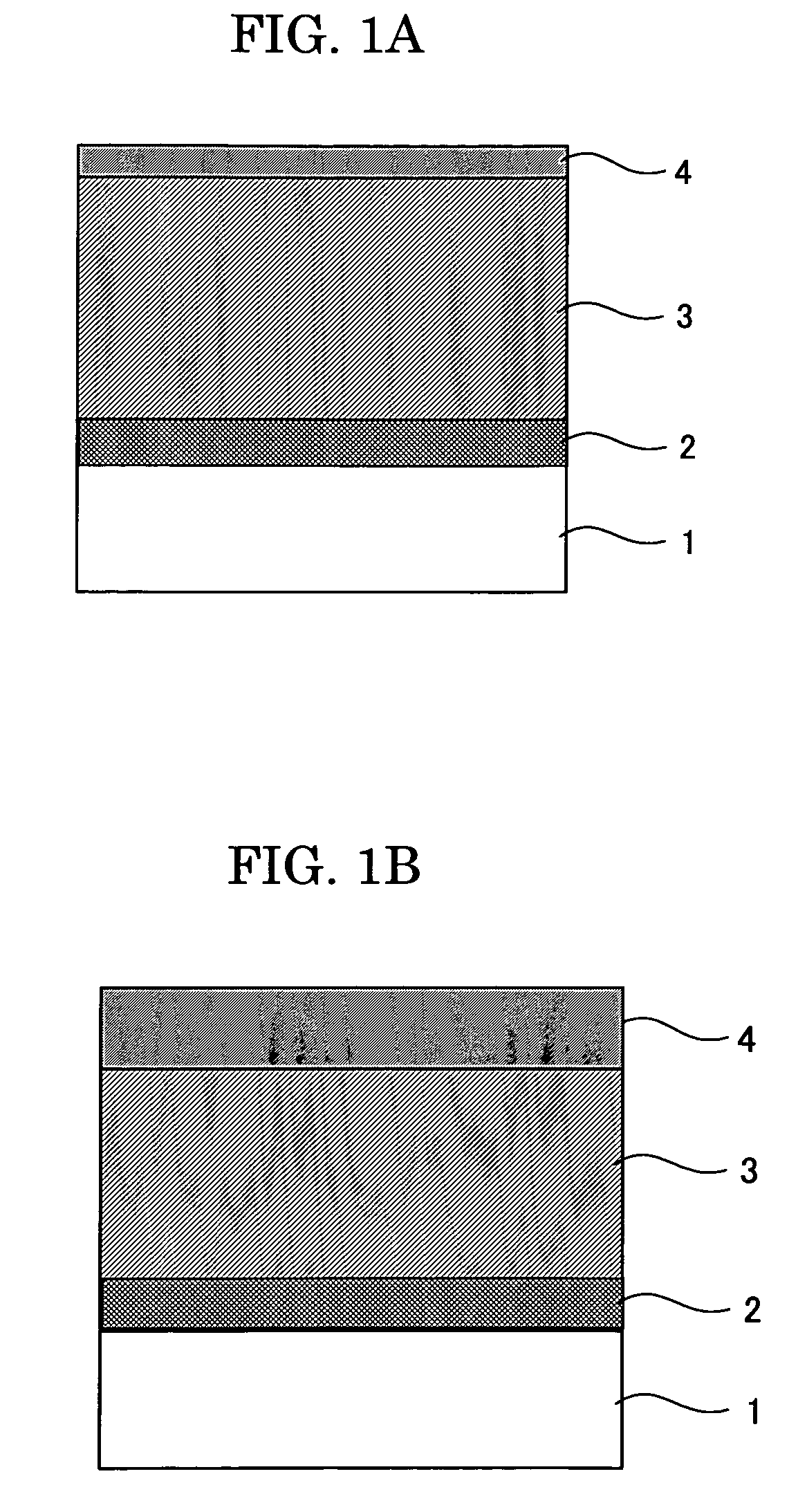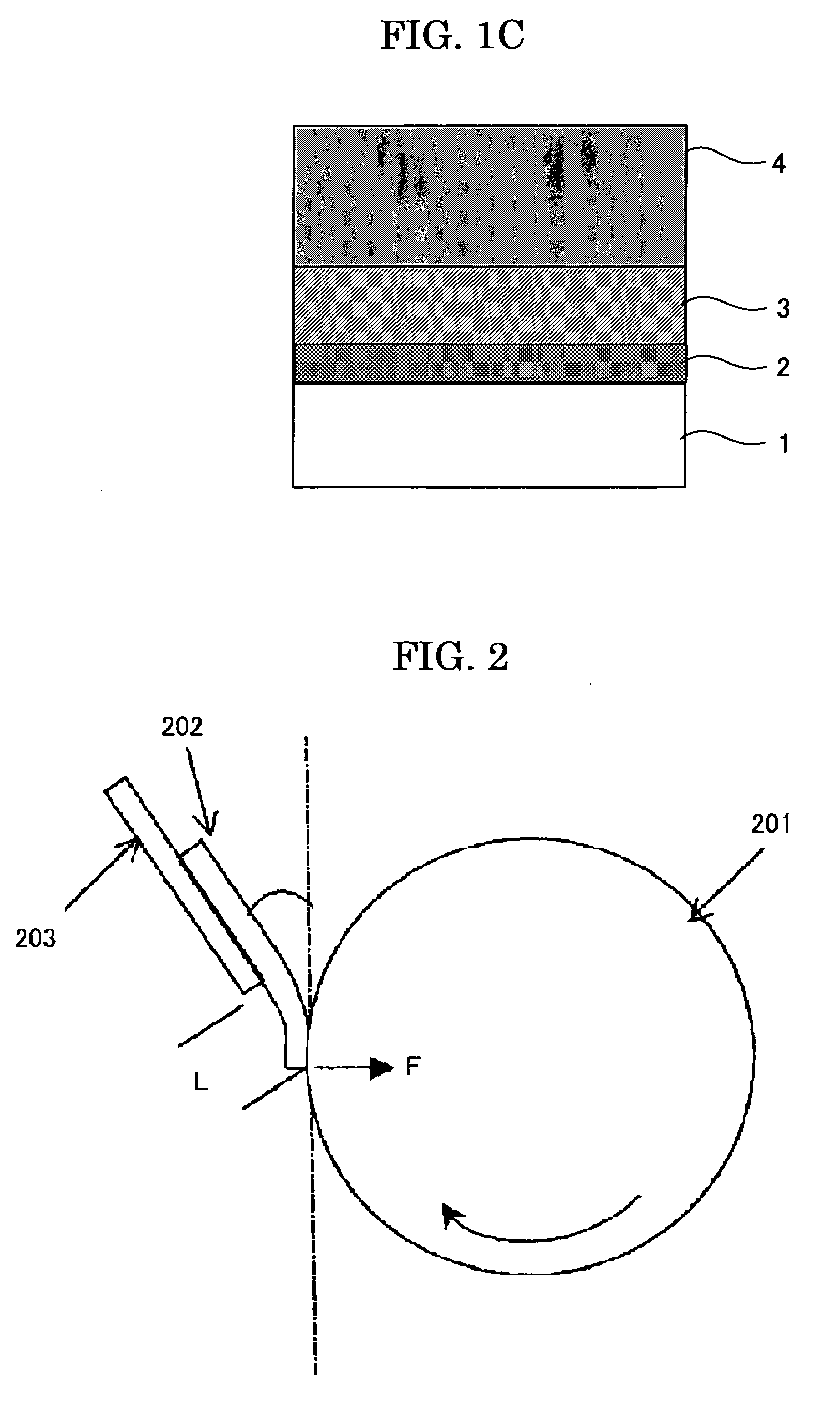The disadvantages are that chemical and mechanical strengths are weak and there may be a case that the conductors are deteriorated and scratches are occurred when many pages are copied or printed.
However, there are many problems on such processes.
When the images are formed at this state, it is not possible to obtain a high quality copy without smear or
blot due to the residual toner.
However, the photoconductor in which the BPZ
polycarbonate is used as a binder resin has still insufficient with
wear resistance and durability.
Such case also is insufficient durability.
However, since the
surface layer is cured, the surface of the photoconductor is not polished.
As a result, there are problems that an image blur is easily occurred by influence of water absorbed under high temperature and
high humidity environment, paper dusts and toner filming easily occur and image failures such as streak or dot shaped are easily generated.
The organic photoconductors are typically less chemically stabile, and is soft due to their components of charge transport substances of lower molecular mass and
organic polymer; therefore, the surface
layers tend to wear significantly due to mechanical stress caused by developing systems and cleaning systems under repeated usages in electrophotographic processes.
Further, rubber
hardness of cleaning blades has been raised and pressure onto photoconductors applied from the cleaning blades has been increased so as to improve cleaning ability in order to enhance
image quality by using toner particles having smaller particle diameters, which inevitably leading to higher wear rate of photoconductors.
The wear of photoconductors certainly degrades sensitivity,
electric properties such as charging ability etc., which resulting in deteriorated images such as lower
image density and background smear.
Further, scratches due to local wear often bring about streak on images due to insufficient cleaning.
However, in the (1) incorporation of curable binders described above,
residual voltage tends to increase owing to impurities such as
polymerization initiators and / or unreacted residual groups due to insufficient compatibility with charge transport substances, thus
image density tents to decrease; in the (2) employment of polymers for charge transport substances described above, the durability cannot be sufficiently improved for satisfying the requirements for organic photoconductors; moreover,
electric properties of organic photoconductors are likely to be unstable since polymers for charge transport substances are difficult to be polymerized and purified, and also
coating liquids of them are typically excessively viscous to be processed.
However, traps on the surface of the inorganic fillers tend to increase residual potential, thereby causing decrease in the
image density.
Also, when unevenness of the photoconductor surface is significant due to the
inorganic filler and the binder resin, cleaning may be insufficient, resulting in toner filming and image deletion.
As such, based on these proposals (1), (2), and (3), the durability of organic photoconductors is not satisfactory on the whole, including electrical durability and mechanical durability.
However, there exist no more than simple descriptions that a charge transport substance may be contained in the protective layer and there exist no specific examples.
Further, when a charge transport substance having a low molecular mass is simply added to the crosslinked charge transporting layer, it may cause problems related with the compatibility to the cured product, thereby
crystallization of charge transport substance having a lower molecular mass and clouding may occur, resulting in not only deterioration of image density by the increase of electrical potential in the
exposure portion, but also reduction in mechanical properties.
In addition, a photoconductor is produced by way of causing reaction of monomers in a condition that a
polymer binder is incorporated; therefore, there will be some problems that a three-dimensional
network structure cannot sufficiently proceed, and a crosslink density becomes low; resulting in not to dramatically exhibit the
wear resistance.
However, the non-reactive resin as the binder is used, since the non-reactive resins are not well compatible with reaction products between the
monomer and the charge transport substance, thus phase separation is likely to occur in the crosslinked charge transporting layer.
This may result in scratches, fixation of an external additive in the toner and paper dusts.
Further, the three-dimensional
network structure cannot proceed sufficiently and the crosslink density becomes low, thus the wear resistance has not been exhibited dramatically.
Further, the
patent literature discloses monomers having two functionalities as specific examples, which cannot bring about sufficient crosslink density and satisfactory wear resistance due to the lower functionalities.
Provided that reactive resins are employed as the binder resin, the bonding density and the crosslink density are possibly not sufficiently high, as the number of crosslinking between molecules is small though molecular mass in the cured product increases, thus
electric properties and wear resistance will not be satisfactory.
However, the photoconductive layer tends to cause higher
internal stress in the cured product, and thus to yield higher
surface roughness and cracks in the crosslinked charge transporting layer using for a long time, since the bulky hole transport compound have two or more chain polymerizable functional groups.
Therefore, conventional photoconductors having the crosslinking photoconductive layer in which the charge transporting structure is chemically bonded are not to have sufficient overall properties at present.
To obtain the high quality images more than ever, there are problems to be solved in improving resolution, high-light reproducibility, colorization, etc.
Particularly, that a developing
system for capable of developing dot latent images truly on the conductor has become important problems.
However, there are still problems in costs being higher and reliability.
However, there still remains problems to be solved such that a background smear and image intensity is poor in the developer including the toner having a
small particle diameter.
However, a carrier spent amount becomes higher than the black toner, the developer is deteriorated, thereby easily to cause the toner distribution and the background smear.
However, conventionally, there is a
disadvantage that the carrier having
small particle diameter tends to adhere on the surface of the photoconductor.
Once the carrier is adhered, there is a utility problem that generates causes of scratches of the photoconductor and a fixing roller.
As a result, a deep scratch will be generated on the photoconductor and this gives a great damage to the
image quality.
 Login to View More
Login to View More 


